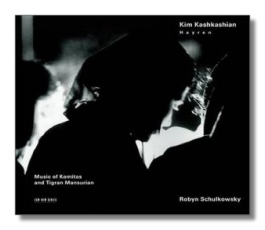
The Internet's Premier Classical Music Source
Related Links
-
Mansurian Reviews
Vardapet Reviews - Latest Reviews
- More Reviews
-
By Composer
-
Collections
DVD & Blu-ray
Books
Concert Reviews
Articles/Interviews
Software
Audio
Search Amazon
Recommended Links
Site News
 CD Review
CD Review
Hayren

Music of Komitas and Tigran Mansurian
- Komitas Vardapet: 11 Songs (arr. Mansurian)
- Tigran Mansurian:
- Havik
- Duet for Viola & Percussion
Kim Kashkashian, viola
Robyn Schulkowsky, percussion
Tigran Mansurian, piano & voice
ECM New Series 1754 DDD 54:25
According to composer/performer Tigran Mansurian, Hayren, the title given to this collection, is "the poetical style most beloved by Armenians, which has a tradition of centuries. [It is] dense with the phonetics and intonation of our language, and the Armenian landscape and aspects of Armenian world-view and sentiment are also present." Both Mansurian and Kim Kashkashian are Armenian, as was Komitas Vardapet (1869-1935), a composer and ethnomusicologist who tirelessly preserved and disseminated Armenian musical culture until 1919, when he suffered a mental breakdown – probably as a consequence, at least in part, of the genocide of the Armenian people. (His birthname was Soghomon Soghomonian until he completed his religious education in 1895.)
Mansurian "adapted" the eleven Komitas selections on this CD. His booklet note doesn't make clear, however, whether the works are entirely Komitas's own, or whether Komitas in turn adapted them from more ancient sources. The note also doesn't identify Komitas's original scoring. Mansurian, however, has scored these pieces for various combinations of viola, voice, piano, and percussion. The presentation is effective, bringing out all the spiritual devotion and ethnically-rich emotionality of Komitas's music. More controversial is Mansurian's decision to take on the vocal duties himself. He doesn't have an attractive voice by any stretch of the imagination; he whines, wails, and grates against the ear. And yet, would a professional singer have been able to perform this music as emotionally as Mansurian has? It's not easy to listen to these performances, but something about them feels absolutely right. Kashkashian's rich, soulful viola adds much to the music, as do the little glints and shimmers of light from the percussion instruments and the piano. The music is quiet and unfettered by complications. The simple yet ineffable message reaches the listener without interference.
As a sort of Prélude to this CD, we are offered Mansurian's Havik, a five-minute bridge into Komitas's world. Kashkashian and Schulkowsky are the dedicatees. The Duet for viola and percussion, at eighteen minutes, is a more extensive bridge out into modern times again. It was premièred at an "Armenian Night" concert at which both Havik and arrangements of Komitas's music were premièred. Again, the music was written for these performers.
As is the case with many ECM New Series releases, this CD is hard to classify, but no less valuable and rewarding for all that. The program transports us not just into a different land or a different time but into a different way of feeling. The suffering of many Eastern European peoples during the past century is translated into music, but rather than attacking us with it, this CD allows us to contemplate and even experience it second-hand, as if it were an album of rare photos and 78-rpm records that you've come across in your great-grandmother's attic. For supplemental listening, you might wish to explore Komitas' Divine Liturgy, movingly performed by an authentic Armenian men's choir on New Albion NA033.
Copyright © 2003, Raymond Tuttle




















